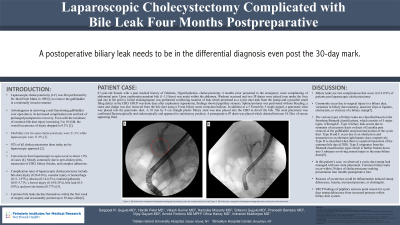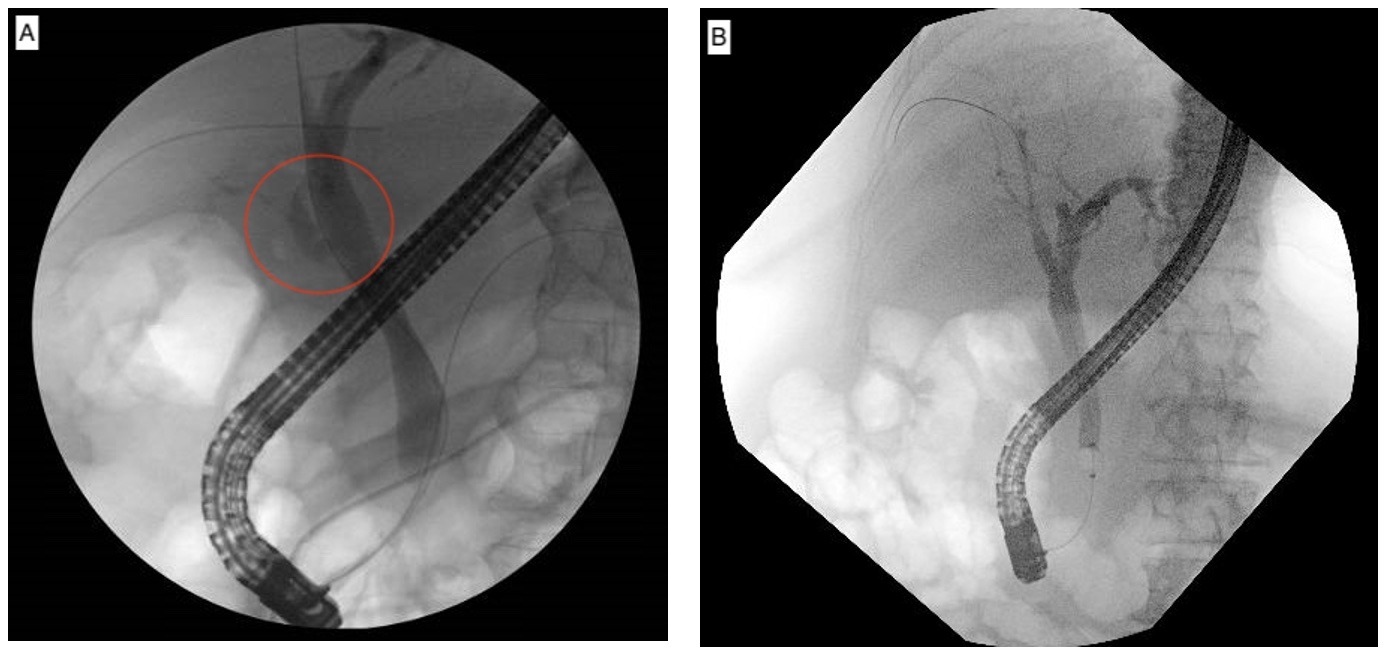Monday Poster Session
Category: Interventional Endoscopy
P2341 - Laparoscopic Cholecystectomy Complicated With Bile Leak Four Months Postoperative
Monday, October 23, 2023
10:30 AM - 4:15 PM PT
Location: Exhibit Hall

Has Audio
- SG
Saigopal R. Gujjula, MD
Staten Island University Hospital
Brooklyn, NY
Presenting Author(s)
Saigopal R. Gujjula, MD1, Hardik Patel, MD2, Vikash Kumar, MD3, Hamsika Moparty, MD3, Srilaxmi Gujjula, MD3, Praneeth Bandaru, MD3, Vijay Gayam, MD3, Arnold Forlemu, MD, MPH3, Olivia Haney, MD2, Indraneil Mukherjee, MD2
1Staten Island University Hospital, Brooklyn, NY; 2Staten Island University Hospital, Staten Island, NY; 3Brooklyn Hospital Center, Brooklyn, NY
Introduction: Laparoscopic cholecystectomy is associated with complications mostly due to peri-cholecystitis, transection of the common bile duct (CBD), biliary fistulas, and complex adhesions. Complication rates of laparoscopic cholecystectomy include bile duct injury (0.26-0.6%), vascular injury or hemorrhage (0.11-1.97%), abscess (0.14-0.3%), retained gallstones (0.81-5.71%), bowel injury (0.14-0.35%), bile leak (0.3-0.9%), and port site hernia (0.77%).
Here, we present a rare case of bile leak that occurred four months after laparoscopic cholecystectomy. The rarity lies in timing, as common bile leaks appear within the first week of surgery and occasionally appear up to 30 days later.
Case Description/Methods: 67-year-old female with a history of diabetes mellitus type II, hyperlipidemia, and cholecystectomy four months earlier presented to the emergency room complaining of abdominal pain. Upon surgical exploration, purulent bile (1.5 liters) was observed within the abdomen. Washout occurred and two Jackson-Pratt (JP) drains were placed. An initial cholangiogram was performed that confirmed the location of the leak was originating from the cystic duct stump. (figure 1). The following day, an endoscopic retrograde cholangiopancreatography (ERCP) was performed. Sphincterotomy was performed due to findings of papillary stenosis and the sludge was removed using a biliary stone extraction balloon. A straight plastic biliary stent was placed in the CBD to divert bile (figure 2). Subsequently, the JP drain was collecting minimal of bilious fluid during the hospital stay which confirmed the treatment of bile leak.
Discussion: Biliary leaks are rare complications that occur in 0.3-0.9% of patients after laparoscopic cholecystectomy. They commonly occur due to surgical injury to a bile duct, which can be attributed to variations in the anatomy of the biliary duct, unsecure clips or ligatures, obstruction, or stricture of a biliary stump. The entirety of cases reported observe a cystic duct stump leak occur within 30 days of cholecystectomy, meaning a presentation occurring four months after surgery particularly rare. Based on the findings of papillary stenosis in the ERCP, possible etiology of bile leak in this situation could be due to inflammation-induced stump dehiscence, trauma, and/or increased intraductal pressure.

Disclosures:
Saigopal R. Gujjula, MD1, Hardik Patel, MD2, Vikash Kumar, MD3, Hamsika Moparty, MD3, Srilaxmi Gujjula, MD3, Praneeth Bandaru, MD3, Vijay Gayam, MD3, Arnold Forlemu, MD, MPH3, Olivia Haney, MD2, Indraneil Mukherjee, MD2. P2341 - Laparoscopic Cholecystectomy Complicated With Bile Leak Four Months Postoperative, ACG 2023 Annual Scientific Meeting Abstracts. Vancouver, BC, Canada: American College of Gastroenterology.
1Staten Island University Hospital, Brooklyn, NY; 2Staten Island University Hospital, Staten Island, NY; 3Brooklyn Hospital Center, Brooklyn, NY
Introduction: Laparoscopic cholecystectomy is associated with complications mostly due to peri-cholecystitis, transection of the common bile duct (CBD), biliary fistulas, and complex adhesions. Complication rates of laparoscopic cholecystectomy include bile duct injury (0.26-0.6%), vascular injury or hemorrhage (0.11-1.97%), abscess (0.14-0.3%), retained gallstones (0.81-5.71%), bowel injury (0.14-0.35%), bile leak (0.3-0.9%), and port site hernia (0.77%).
Here, we present a rare case of bile leak that occurred four months after laparoscopic cholecystectomy. The rarity lies in timing, as common bile leaks appear within the first week of surgery and occasionally appear up to 30 days later.
Case Description/Methods: 67-year-old female with a history of diabetes mellitus type II, hyperlipidemia, and cholecystectomy four months earlier presented to the emergency room complaining of abdominal pain. Upon surgical exploration, purulent bile (1.5 liters) was observed within the abdomen. Washout occurred and two Jackson-Pratt (JP) drains were placed. An initial cholangiogram was performed that confirmed the location of the leak was originating from the cystic duct stump. (figure 1). The following day, an endoscopic retrograde cholangiopancreatography (ERCP) was performed. Sphincterotomy was performed due to findings of papillary stenosis and the sludge was removed using a biliary stone extraction balloon. A straight plastic biliary stent was placed in the CBD to divert bile (figure 2). Subsequently, the JP drain was collecting minimal of bilious fluid during the hospital stay which confirmed the treatment of bile leak.
Discussion: Biliary leaks are rare complications that occur in 0.3-0.9% of patients after laparoscopic cholecystectomy. They commonly occur due to surgical injury to a bile duct, which can be attributed to variations in the anatomy of the biliary duct, unsecure clips or ligatures, obstruction, or stricture of a biliary stump. The entirety of cases reported observe a cystic duct stump leak occur within 30 days of cholecystectomy, meaning a presentation occurring four months after surgery particularly rare. Based on the findings of papillary stenosis in the ERCP, possible etiology of bile leak in this situation could be due to inflammation-induced stump dehiscence, trauma, and/or increased intraductal pressure.

Figure: Figure 1: (A) Endoscopic retrograde cholangiopancreatography presenting cystic duct stump leak (red circle)
Figure 2: (B) Endoscopic retrograde cholangiopancreatography two months post stent placement
Figure 2: (B) Endoscopic retrograde cholangiopancreatography two months post stent placement
Disclosures:
Saigopal Gujjula indicated no relevant financial relationships.
Hardik Patel indicated no relevant financial relationships.
Vikash Kumar indicated no relevant financial relationships.
Hamsika Moparty indicated no relevant financial relationships.
Srilaxmi Gujjula indicated no relevant financial relationships.
Praneeth Bandaru indicated no relevant financial relationships.
Vijay Gayam indicated no relevant financial relationships.
Arnold Forlemu indicated no relevant financial relationships.
Olivia Haney indicated no relevant financial relationships.
Indraneil Mukherjee indicated no relevant financial relationships.
Saigopal R. Gujjula, MD1, Hardik Patel, MD2, Vikash Kumar, MD3, Hamsika Moparty, MD3, Srilaxmi Gujjula, MD3, Praneeth Bandaru, MD3, Vijay Gayam, MD3, Arnold Forlemu, MD, MPH3, Olivia Haney, MD2, Indraneil Mukherjee, MD2. P2341 - Laparoscopic Cholecystectomy Complicated With Bile Leak Four Months Postoperative, ACG 2023 Annual Scientific Meeting Abstracts. Vancouver, BC, Canada: American College of Gastroenterology.
